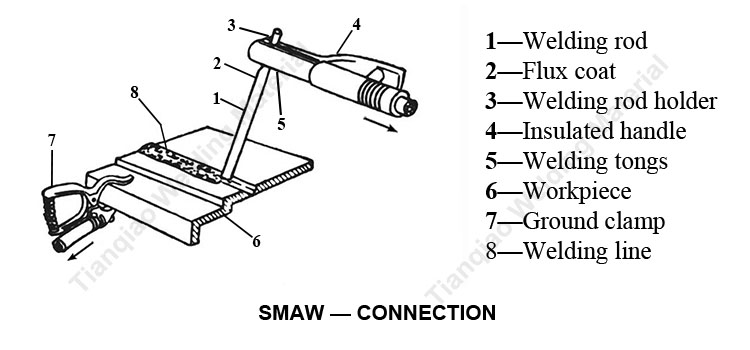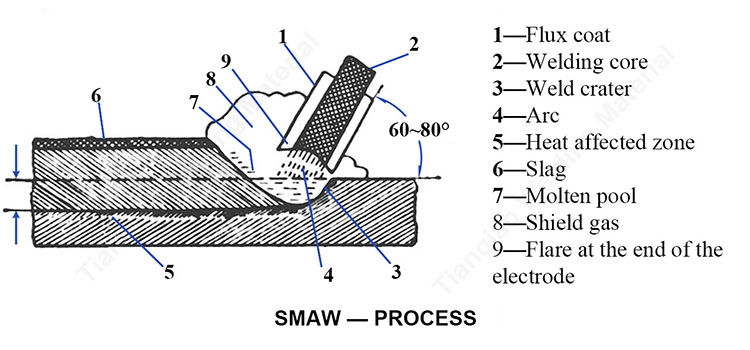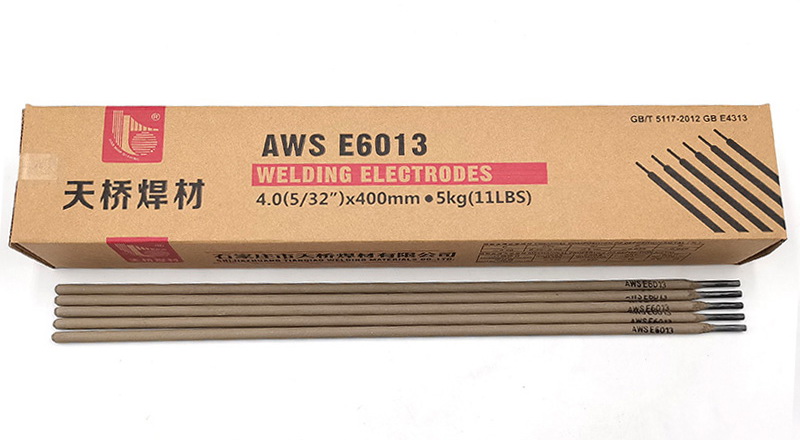Shielded Metal Arc Welding (abbreviated as SMAW). The principle is: an arc is generated between the coated electrode and the base metal, and the welding method using the arc heat to melt the electrode and the base metal. The outer layer of the electrode is covered with welding flux and melts when exposed to heat, which has the functions of stabilizing the arc, forming slag, deoxidizing, and refining. Because it requires simple equipment and flexible operation, it can be easily welded to welds formed by different positions and different joints in space. Therefore, it is still widely used at present.
Figure 1: Shielded Metal Arc Welding-connection
Manual arc welding is shown in the figure:
Before welding, connect the welded workpiece and the welding tongs to the two poles of the electric welding machine and clamp the welding rod with the welding tongs. During welding, the welding rod and the workpiece are in instantaneous contact, forming a short circuit, and then they are separated by a certain distance (about 2-4mm), and the arc is ignited.
Figure 2: Shielded Metal Arc Welding-process
The workpiece under the arc immediately melts to form a semi-oval molten pool. After the electrode coating is melted, part of it becomes a gas that surrounds the arc to isolate it from the air, thereby protecting the liquid metal from oxygen and nitrogen; part of it becomes molten slag, or sprayed into the molten pool alone, or melted with the core The molten droplets of liquid metal are sprayed to the molten pool together.
In the arc and the molten pool, the liquid metal, slag and arc gas will undergo certain physical and chemical changes with each other, such as the dissolution of the gas into the liquid metal and the oxidation-reduction reaction. The gas and slag in the molten pool float up due to its light weight. When the arc is removed, the temperature drops and the metal and slag will solidify one after another. In this way, the two pieces of metal are joined by the melted and crystallized weld metal. Because the shrinkage of the slag is different from that of the metal, it will slip on the slag shell and the metal boundary, and the slag shell may fall off automatically, or fall off after being knocked, and the metal weld seam with fish scales can be exposed.
The main equipment of manual arc welding is electric welding machine. Electric welding machine is a power source that generates welding arc, and there are two kinds of AC and DC. At present, there are many kinds of electric welding machines produced in China, which can be divided into AC electric welding machines and DC electric welding machines according to their structure.
There are two different connection methods for DC welding machines. When the electrode is connected to the negative electrode and the workpiece is connected to the positive electrode, it is the positive connection method; the opposite is the reverse connection method. Generally, when welding with alkaline low-hydrogen electrode (such as E7018, E7016), in order to make the arc burn stably, it is stipulated to use the DC reverse connection method; when using the acid electrode (such as E6013, J422) to weld thick steel plates, the forward connection method is used, because the anode part The temperature is higher than the cathode part, and the forward connection method can get a larger penetration depth; when welding thin steel plates and non-ferrous metals, the reverse connection method is used. When welding with alternating current, since the polarity changes alternately, there is no need to choose the polarity connection.
The welding material for manual welding is an electric welding rod, which consists of a steel core and a coating on the outside of the steel core(Also see The composition of the welding electrode).
Welding core
The role of the steel core (welding core) is mainly to conduct electricity and form a deposited metal with a certain composition at the end of the electrode. The welding core can be made of various steels. The composition of the welding core directly affects the composition and performance of the deposited metal. Therefore, the welding core is required to minimize the content of harmful elements. In addition to limiting S and P, some welding rods have required the welding core to control As, Sb, Sn and other elements.
Figure 3: Tianqiao welding electrode E6013
Flux coat
Electrode coating can also be called paint. The main purpose of coating it on the core is to facilitate the welding operation and to ensure that the deposited metal has a certain composition and performance. Electrode coatings can be mixed with hundreds of raw material powders such as oxides, carbonates, silicates, organics, fluorides, ferroalloys and chemical products according to a certain formula ratio. Various raw materials can be divided into the following categories according to their role in the electrode coating:
1. Stabilizer makes the electrode easy to start the arc and can keep the arc burning stably during the welding process. Any substance that is easy to ionize can stabilize the arc. Generally, compounds of alkali metals and alkaline earth metals, such as potassium carbonate, sodium carbonate, marble, etc., are used.
2. Slag-forming agent can form molten slag with certain physical and chemical properties during welding, covering the surface of the molten metal, protecting the welding pool and improving the shape of the weld.
3. Deoxidizer through the metallurgical chemical reaction in the welding process to reduce the oxygen content in the weld metal and improve the mechanical properties of the weld. The main deoxidizers are ferromanganese, ferrosilicon, and ferro-titanium.
4. Gas generating agent can separate and liberate gas under the action of arc high temperature to protect the arc and molten pool and prevent the intrusion of oxygen and nitrogen in the surrounding air.
5. Alloying agent It is used to compensate for the burning of alloy elements and the transition of alloy elements to the weld during the welding process to ensure that the weld metal obtains the necessary chemical composition and performance.
6. Plasticizing Lubricant Increase the plasticity, slippage and fluidity of the coating powder in the welding rod pressing process to improve the pressing quality of the welding rod and reduce the eccentricity.
7. Adhesives Make the coating powder have a certain viscosity during the compression coating process, can firmly bond with the welding core, and make the welding rod coating have a certain strength after drying.
Post time: Jul-27-2021



